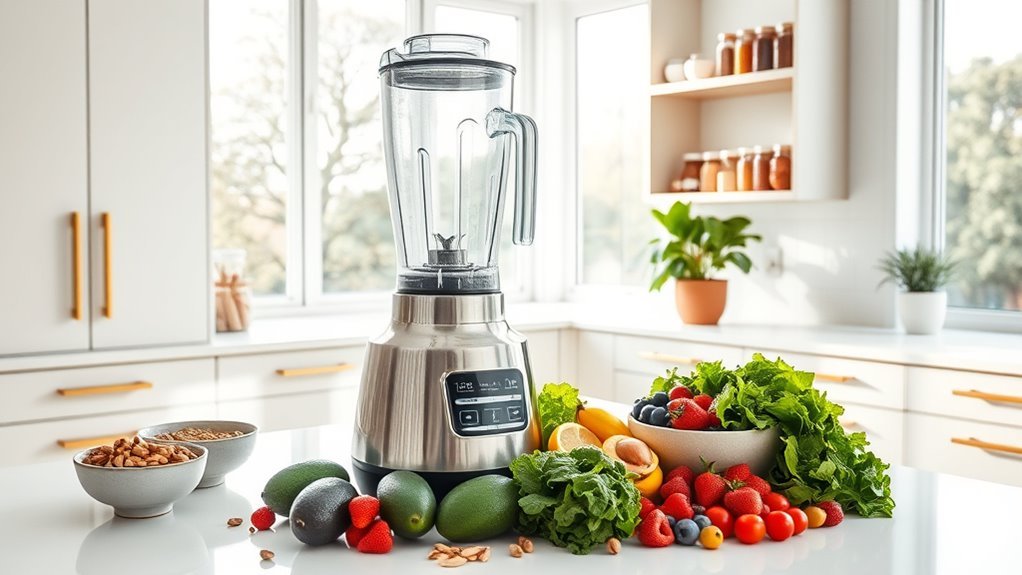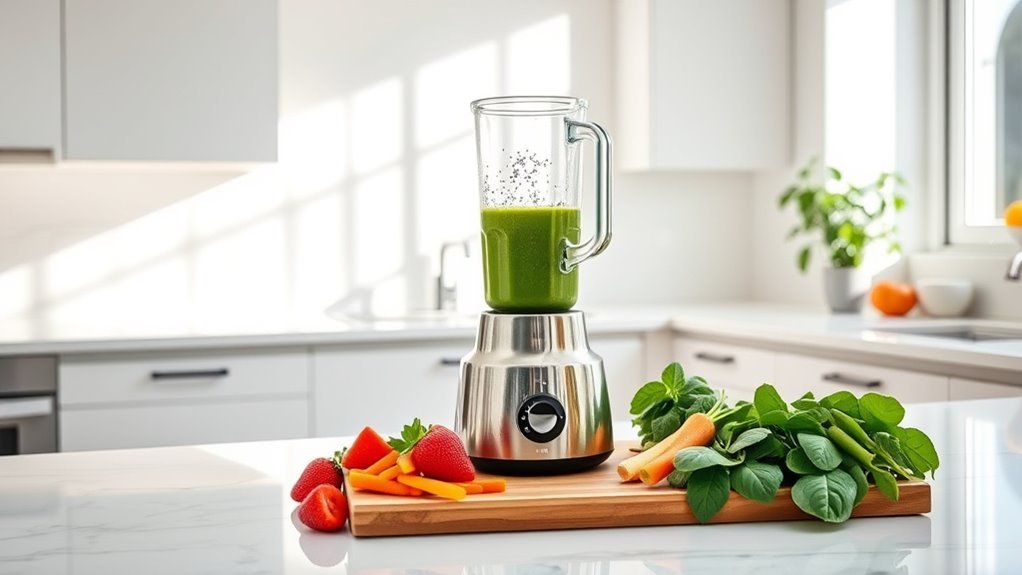We’ve got three foolproof methods to keep your high-powered blender pristine. First, deploy our quick self-cleaning trick: warm water, dish soap, and a 1-minute blend cycle. For tougher jobs, harness the power of natural solutions like baking soda paste and vinegar combinations. When facing stubborn residue, break out the specialized tools – a long straw brush paired with a coarse Euroscrubby sponge. There’s more to mastering blender maintenance than meets the eye.
Quick Self-Cleaning Method Using Dish Soap

When it comes to keeping your blender spotless, there’s no method more efficient than the quick self-cleaning technique.
We’ll show you how to clean your blender in minutes, using nothing but warm water and a few drops of dish soap.
Here’s our foolproof blender cleaning approach: Fill the blender container halfway with warm water, add unscented dish soap, and secure the lid.
Run it on high for 1-2 minutes – let the blender do the work for you. Rinse thoroughly and you’re done. No scrubbing required.
For best results, deploy this self-cleaning method right after use.
It’s your first line of defense against stuck-on residue. Trust us – this simple cleaning tip will keep your high-powered blender pristine and ready for your next culinary adventure. High-performance blenders are designed to handle tough ingredients effectively, making cleaning even more crucial after use.
Deep Clean With Natural Cleaning Solutions
Although your blender might look clean after a quick wash, natural cleaning solutions pack the punch needed for a truly spotless deep clean.
We’ve found baking soda mixed with water creates a powerful paste that demolishes cloudiness and stubborn stains – just apply with elbow grease and wait 30 minutes.
For an unbeatable deep cleaning method, we combine white vinegar with hot water to tackle those pesky chia seed residues and mineral deposits.
Want to level up? Mix vinegar and baking soda together. This dynamic duo obliterates odors while restoring clarity to your blender parts.
Pro tip: For maximum results, alternate between these natural solutions regularly. Additionally, maintaining a clean blender can help ensure longer warranty periods as manufacturers recommend proper care to extend the lifespan of your appliance.
A monthly deep clean using lemon juice and baking soda won’t just keep your blender sparkling – it’ll extend its lifespan dramatically.
Tackling Stubborn Stains and Residue

Stubborn stains and residue don’t stand a chance against our proven arsenal of cleaning techniques. When dealing with tough buildup, we’ll skip the harsh chemicals and create a powerful paste using baking soda and water. Let it sit for 30 minutes – trust us, it’s worth the wait.
For extra cleaning strength, we combine warm vinegar and water, perfect for battling those persistent chia seeds and garlic bits.
Our secret weapon? A long straw brush with a bent end that safely navigates those tricky blender blades. Pair that with a coarse Euroscrubby sponge, and you’ve got an unbeatable cleaning combo.
Frequently Asked Questions
What Is the Best Way to Clean a Blender?
We recommend filling your blender halfway with warm water, adding dish soap, and blending for two minutes. For tough stains, use a baking soda paste or vinegar solution.
How to Remove Cloudiness From Blender?
Did you know 75% of blender cloudiness comes from mineral buildup? We’ll remove cloudy residue by soaking in hot water with dishwasher detergent for 2 hours, then scrub and rinse thoroughly.
How Long to Soak Blender in Vinegar?
We recommend soaking your blender in vinegar for 10-30 minutes, depending on residue buildup. For best odor removal and eco-friendly cleaning, mix equal parts warm water and vinegar during maintenance.
Can You Clean a Blender by Blending Soapy Water?
We can quickly clean a blender by blending warm water and dish soap for 1-2 minutes. It’s safe for motor and blades, eliminates stubborn stains, and works better than dishwashing or soaking.

